Waste-to-Energy Technologies Market Size
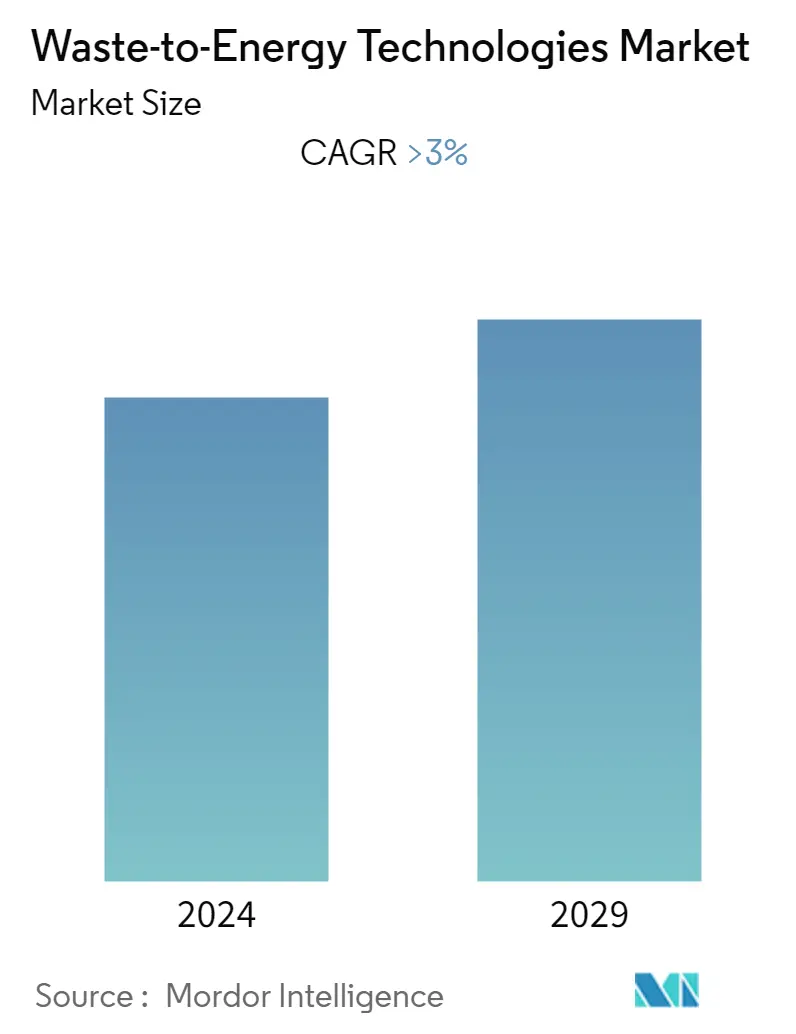
| Study Period | 2021 - 2029 |
| Base Year For Estimation | 2023 |
| CAGR | 3.00 % |
| Fastest Growing Market | Europe |
| Largest Market | Asia Pacific |
| Market Concentration | Low |
Major Players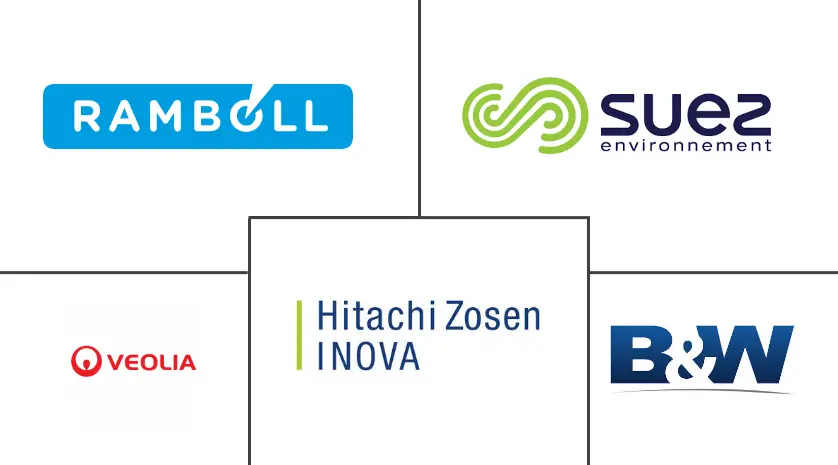
*Disclaimer: Major Players sorted in no particular order |
Waste-to-Energy Technologies Market Analysis
The waste-to-energy technologies market is expected to record a CAGR of more than 3% during the forecast period.
The market was negatively impacted by COVID-19. Presently, the market has reached pre-pandemic levels.
- The factors driving the market include supportive government initiatives and efforts to reduce dumps and open burning of waste in both developed and emerging economies across the world.
- However, the high capital and operation cost of waste-to-energy plants and the requirement of skilled staff to operate and maintain the sophisticated technologies may act as a restraint to the market's growth in the future.
- Waste generation is overgrowing with the increasing population. The global waste is expected to reach around 3.4 billion tons by 2050. The direct relation between population and income level is expected to increase the waste volume. Daily per capita waste generation in developed and emerging economies is also expected to increase by 40%. The need to stabilize future waste may increase the adoption of waste-to-energy technology in the future.
- Europe is one of the prominent regions to have waste-to-energy technology as it has a significant potential to reduce the region's dependency on gas imports while helping it participate in the efforts toward a carbon-neutral Europe.
Waste-to-Energy Technologies Market Trends
This section covers the major market trends shaping the Waste-to-Energy Technologies Market according to our research experts:
Municipal Solid Waste Incineration (MSWI) as a Prominent Technology
- During the MSWI process, waste materials are burned inside a specific chamber by raising the temperature to around 850-1450 degrees Celsius, and oxygen is added to have a combustion reaction. A minimum calorific value of the waste is required for the self-combustion of the trash.
- During the process, exhaust gases called flue gases are created, which are cleaned up before exiting the facility. This flue gas contains the heat energy that is utilized to generate electricity or for heating purposes.
- The operation of MSWI is more complex than the operation of a sanitary landfill. It requires well-developed technical and management skills to set and adjust the parameter for the effective operation of the plant.
- With the several advantages of MSWI, the segment is expected to be the prominent technology as compared to other segments. The normal range of net electrical energy that can be produced per ton of waste burnt is 500-600 kWh. Thus, the incineration of around 2,200 ton of waste each day will generate approximately 50 MW of electrical power.
- Therefore, due to such advantages and benefits, municipal solid waste incineration (MSWI) is expected to grow during the forecast period, further driving the waste-to-energy technologies market.
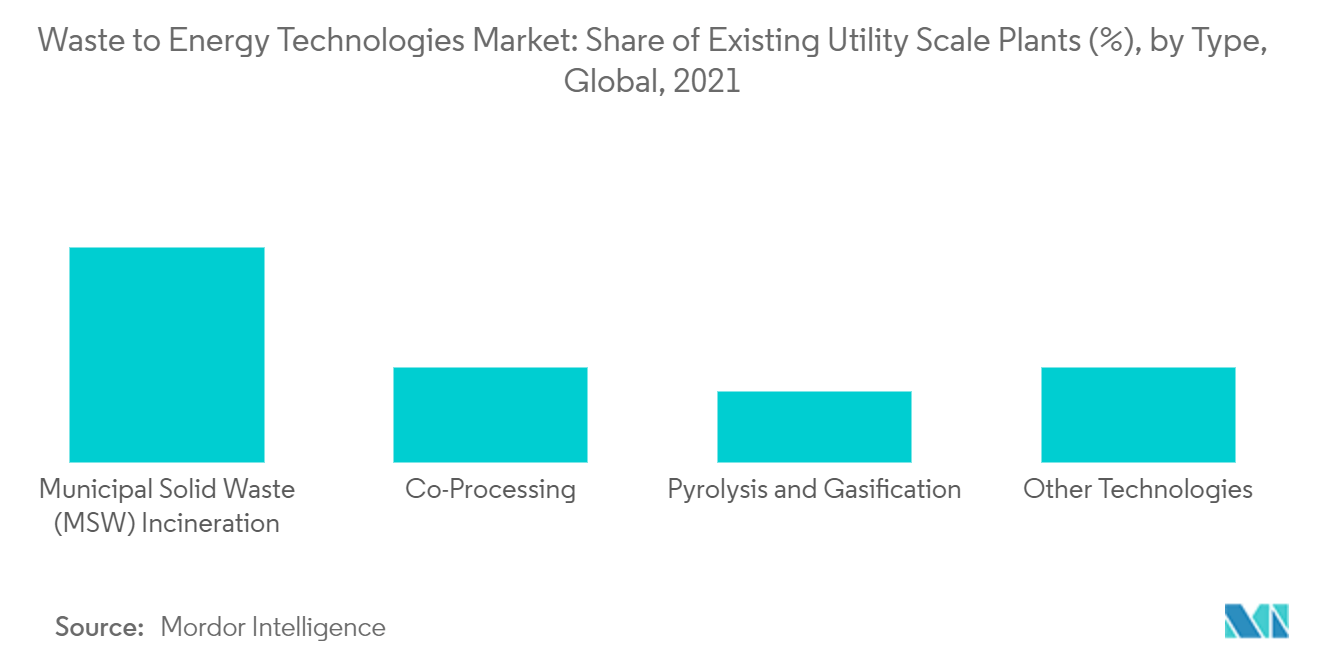
Europe as a Significant Market
- Europe is one of the prominent regions to have developed its waste-to-energy technology. According to the Confederation of European Waste-to-Energy Plants (CEWEP), waste-to-energy plants could produce 189 TWh of useful energy per year by 2035, which would be equivalent to 19.4 billion m³ of natural gas in terms of primary energy.
- Due to cold weather, Sweden and Denmark have several combined heat and power (CHP) waste-to-energy plants, like Aros, Vartan, Herning, etc., which generate more than 100 kilowatt (kW) electricity of energy.
- Europe is estimated to have nearly 330 waste-to-energy plants in the future, with a capacity of around 50 million metric tons annually. The addition of plants is expected to control the rising volume of waste in the region.
- Germany had the most municipal waste energy plants installed capacity in Europe in 2021. In the same year, roughly 1,010 megawatts were deployed around the country. In total, Europe's waste-to-energy capacity was 5.1 gigatons.
- In April 2022, a joint venture initiative with the Aarau-Lenzburg Regional Waste Disposal Association (GEKAL) was established with HZI, the Swiss-Japanese cleantech enterprise. HZI plans to use power from the Buchs Energy from the waste plant to electrolyze hydrogen and oxygen. An alkaline electrolysis method capable of producing 550 Nm3/h of green hydrogen at 350 bar will be employed, meeting both the SAE 2719 and ISO 14687 quality standards for hydrogen fuel.
- Thus, with the increasing installed capacity and development of initiatives in waste-to-energy technologies, Europe is expected to record a high CAGR during the forecast period.
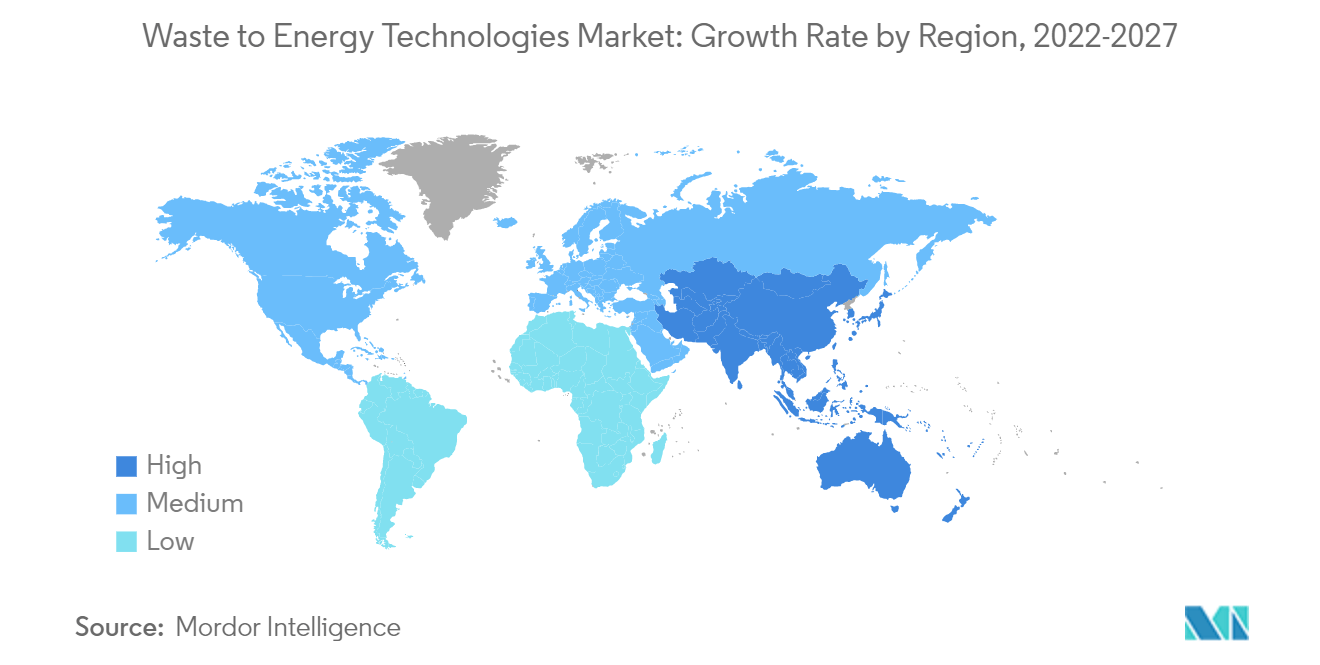
Waste-to-Energy Technologies Industry Overview
The waste-to-energy technologies market is moderately fragmented. The key owners/operators in the market (not in a particular order) include Babcock & Wilcox Enterprises Inc., Ramboll Group AS, Veolia, Babcock & Wilcox Volund AS, Hitachi Zosen Inova AG, and Suez Environnement.
Waste-to-Energy Technologies Market Leaders
-
Babcock & Wilcox Enterprises, Inc
-
Ramboll Group
-
Veolia
-
Babcock & Wilcox Vølund A/S
-
Hitachi Zosen Inova AG
*Disclaimer: Major Players sorted in no particular order
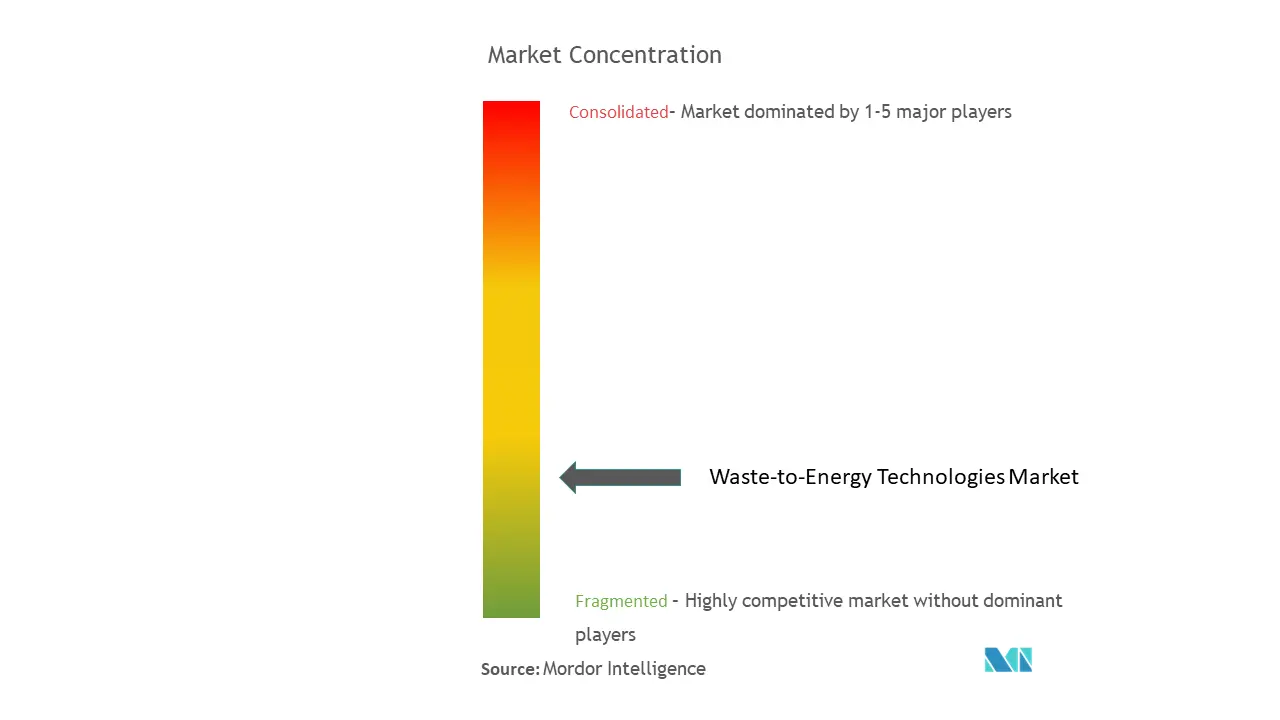
Waste-to-Energy Technologies Market News
- As of July 2022, the construction of Delhi's fourth waste-to-energy plant in Tehkhand, southeast Delhi, was nearing completion. According to a senior Municipal Corporation of Delhi (MCD) official, the plant will generate 25 megawatts (MW) of power by utilizing 2,000 ton of municipal solid waste (MSW) discharged at the Okhla landfill site daily.
- In April 2022, Doosan Lentjes, as a general contractor, was constructing one of Europe's most modern waste-to-energy (WtE) plants in Wiesbaden, Germany. The new plant, with a capacity of around 240,000 ton per year, can thermally treat residual waste and refuse-derived fuel (RDF) generated in the Hessian state capital in a dependable and environmentally responsible manner.
- As of December 2022, Thailand aimed to build 79 waste-to-energy facilities with a total installed capacity of 619.28 MW in the next few years, according to the Pollution Control Department (PCD). Each facility will have a minimum of a 20-year operating contract, and many will be created with international technology or money.
Waste-to-Energy Technologies Market Report - Table of Contents
1. INTRODUCTION
- 1.1 Scope of the Study
- 1.2 Market Definition
- 1.3 Study Assumptions
2. EXECUTIVE SUMMARY
3. RESEARCH METHODOLOGY
4. MARKET OVERVIEW
- 4.1 Introduction
- 4.2 Existing Waste-to-energy Technology
- 4.3 Waste-to-Energy Technology Market in USD billion (in 2027)
- 4.4 Recent Trends and Developments
- 4.5 Government Policies and Regulations
-
4.6 Market Dynamics
- 4.6.1 Drivers
- 4.6.2 Restraints
- 4.7 Supply Chain Analysis
-
4.8 Porter's Five Forces Analysis
- 4.8.1 Bargaining Power of Suppliers
- 4.8.2 Bargaining Power of Consumers
- 4.8.3 Threat of New Entrants
- 4.8.4 Threat of Substitute Products and Services
- 4.8.5 Intensity of Competitive Rivalry
5. MARKET SEGMENTATION
-
5.1 By Technology
- 5.1.1 Municipal Solid Waste (MSW) Incineration
- 5.1.2 Co-processing
- 5.1.3 Pyrolysis and Gasification
- 5.1.4 Other Technologies
- 5.1.5
-
5.2 By Geography
- 5.2.1 North America
- 5.2.2 Asia-Pacific
- 5.2.3 Europe
- 5.2.4 South America
- 5.2.5 Middle East and Africa
6. COMPETITIVE LANDSCAPE
- 6.1 Mergers and Acquisitions, Joint Ventures, Collaborations, and Agreements
- 6.2 Strategies Adopted by Leading Players
-
6.3 Company Profiles
- 6.3.1 Babcock & Wilcox Enterprises Inc.
- 6.3.2 Ramboll Group AS
- 6.3.3 Veolia Group
- 6.3.4 Babcock & Wilcox Volund AS
- 6.3.5 Hitachi Zosen Inova AG
- 6.3.6 Suez Environnement
- 6.3.7 China Everbright International Limited
- 6.3.8 Covanta Holding Corporation
- 6.3.9 Amec Foster Wheeler PLC
- 6.3.10 Abu Dhabi National Energy Company PJSC (Taqa)
- *List Not Exhaustive
7. MARKET OPPORTUNITIES AND FUTURE TRENDS
** Subject To AvailablityWaste-to-Energy Technologies Industry Segmentation
Waste-to-energy technologies imply a set of technologies that treat municipal solid waste (MSW) to extract energy in the form of heat and electricity. This technology also helps obtain biogas as an alternate form of fuel.
The waste-to-energy technologies market is segmented by technology and geography. By technology, the market is segmented into municipal solid waste (MSW) incineration, co-processing, pyrolysis and gasification, and other technologies. By geography, the market is segmented into North America, Asia-Pacific, Europe, South America, and Middle East and Africa. The report also covers the market size and forecasts for the waste-to-energy technologies market across the major countries of the regions. For each segment, the market sizing and forecasts have been done on the revenue (USD billion).
| By Technology | Municipal Solid Waste (MSW) Incineration |
| Co-processing | |
| Pyrolysis and Gasification | |
| Other Technologies | |
| By Geography | North America |
| Asia-Pacific | |
| Europe | |
| South America | |
| Middle East and Africa |
Waste-to-Energy Technologies Market Research FAQs
What is the current Waste-to-Energy Technologies Market size?
The Waste-to-Energy Technologies Market is projected to register a CAGR of greater than 3% during the forecast period (2024-2029)
Who are the key players in Waste-to-Energy Technologies Market?
Babcock & Wilcox Enterprises, Inc, Ramboll Group , Veolia, Babcock & Wilcox Vølund A/S and Hitachi Zosen Inova AG are the major companies operating in the Waste-to-Energy Technologies Market.
Which is the fastest growing region in Waste-to-Energy Technologies Market?
Europe is estimated to grow at the highest CAGR over the forecast period (2024-2029).
Which region has the biggest share in Waste-to-Energy Technologies Market?
In 2024, the Asia Pacific accounts for the largest market share in Waste-to-Energy Technologies Market.
What years does this Waste-to-Energy Technologies Market cover?
The report covers the Waste-to-Energy Technologies Market historical market size for years: 2021, 2022 and 2023. The report also forecasts the Waste-to-Energy Technologies Market size for years: 2024, 2025, 2026, 2027, 2028 and 2029.
Waste-to-Energy Technologies Industry Report
Statistics for the 2024 Waste-to-Energy Technologies market share, size and revenue growth rate, created by Mordor Intelligence™ Industry Reports. Waste-to-Energy Technologies analysis includes a market forecast outlook 2029 and historical overview. Get a sample of this industry analysis as a free report PDF download.



